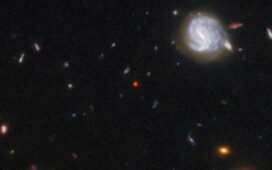In the expanding Universe, different ways of measuring its rate give incompatible answers. Nobel Laureate Adam Riess explains what it means.
One of the most surprising discoveries in all of astronomical history occurred nearly a full century ago: when we discovered that the distant galaxies in our Universe aren’t stationary, but are mutually receding from one another. This realization first came about in 1927, and has since been interpreted to mean that the Universe is expanding, with the space between galaxies, galaxy groups, and galaxy clusters “stretching” to greater and greater distances as time continues onwards. For most of the 20th century, the main quest of cosmology was to measure two parameters: how fast the Universe was expanding right now, and how that expansion rate changed and evolved over time.
In the late 1990s and early 2000s, both of those questions were finally answered with sufficiently good data. Our Universe was expanding at a rate of around 72 km/s/Mpc, with an uncertainty of only around 10%, and the recession speed of a distant galaxy wasn’t decreasing as we expected, but was actually increasing as time goes on. The latter discovery was a tremendous surprise, and compelled us to add a new species…















